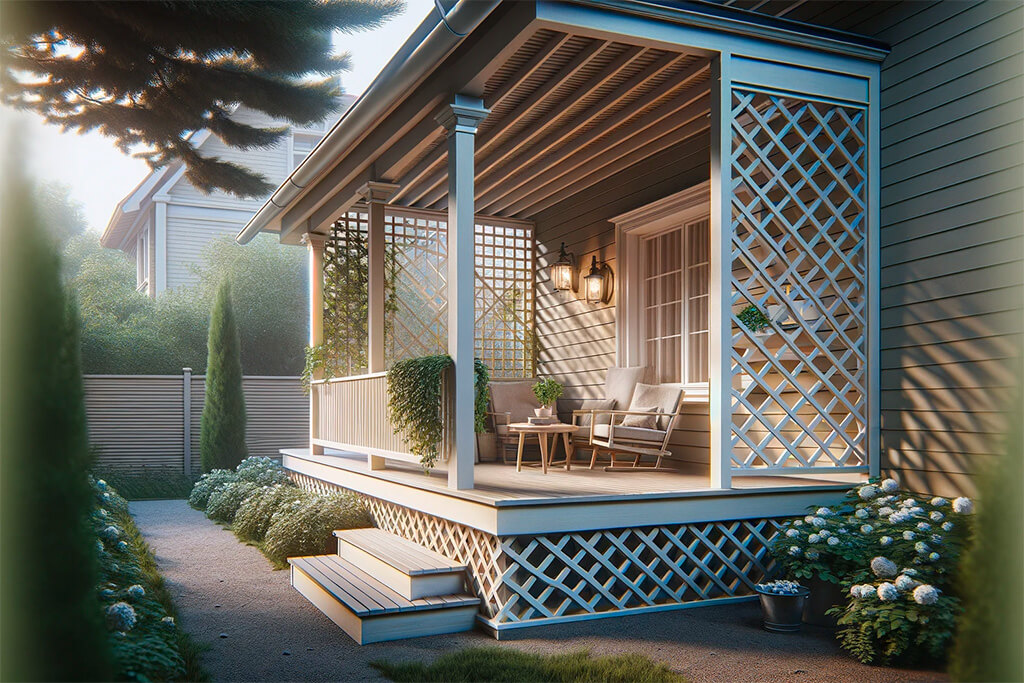Welcome, DIY enthusiasts and skilled builders! We’re diving into the world of enhancing your outdoor space by installing lattice under your deck. This isn’t just a cosmetic upgrade, it’s a multifaceted enhancement for your home. Lattice work can elegantly conceal the less appealing aspects under your deck, deter those pesky critters, and even boost your home’s overall ventilation. It’s a practical and visually appealing addition to any deck.
Whether you’re just starting in the world of DIY or you’re a seasoned construction professional, this guide is tailored for you. With a focus on clarity and practicality, I’ll walk you through every step, ensuring that your project is a success, regardless of your skill level.

Choosing the Right Lattice for Your Deck
Choosing the Material: Wood vs. Vinyl
- Wood Lattice: This traditional choice offers a natural aesthetic. Remember, it requires maintenance like staining and sealing to preserve its look and longevity.
- Vinyl Lattice: For those seeking a low-maintenance solution, vinyl is an excellent choice. It’s resilient, doesn’t require painting, and withstands the elements well, though it may not have the same natural appeal as wood.
Selecting Style and Color
- Complementing Your Deck: The key here is harmony between your deck and the lattice. Ensure the style and color you choose resonates with the existing structure. A mismatched lattice can detract from your deck’s appearance.
- Durability Over Trends: While it’s tempting to follow the latest trends, opt for a style and color that you’ll appreciate long-term. Your future self will thank you.
Tools and Materials Needed
Let’s talk about the tools and materials you’ll need. Always check your existing toolkit before purchasing new items – you might be surprised by what you already have.
Essential Tools:
- Tape measure
- Circular saw or handsaw
- Drill with various screwdriver bits
- Level for accuracy
- Jigsaw for custom cuts
- Safety gear, including goggles and gloves
Required Materials:
- Lattice panels of your chosen material
- Screws and hinges for secured installation
- Wood trim for a finished look
- Concrete mix for setting new posts, if necessary
Purchasing Tips: Your local hardware store or larger home improvement centers are great places to start. Online retailers can also offer competitive pricing.

Preparing for Installation
Proper preparation is crucial for a smooth installation process. Safety and accuracy are paramount here.
Accurate Measurement:
- Double-check your measurements to ensure a perfect fit.
- Allow a small margin for expansion, particularly with wooden lattice.
Safety Considerations:
- Ensure the stability of the deck area to prevent accidents.
- Clear the work area of any obstructions to maintain a safe environment.
Preliminary Steps:
- Inspect the area under your deck for any existing damage or issues that need addressing.
- Confirm that the deck structure can safely support the lattice installation.
With these foundational steps in place, you’re well on your way to successfully installing lattice under your deck. Let’s proceed to the actual installation, where precision and attention to detail will bring your project to life.
Step-by-Step Installation Guide
In my years of decking out decks, I’ve honed a no-nonsense approach to installing lattice. Let’s break it down into manageable steps, so you can tackle this project with confidence and precision.
- Frame the Area: Begin by crafting a sturdy frame beneath your deck. Opt for pressure-treated wood to ensure longevity against the elements. Leveling is key. An unlevel frame leads to a skewed lattice installation, which is a headache you don’t want.
- Cutting the Lattice: Measure the frame opening accurately, then cut your lattice accordingly. A circular saw is your best bet for a clean, straight cut. Remember to leave about a quarter-inch gap for expansion and contraction. Materials behave differently across seasons.
- Attaching the Lattice: Fasten the lattice to the frame using screws or nails, but don’t overdo the tightening. Over-tightening can lead to warping over time. If you’re working with wood lattice, pre-drilling holes will prevent any unwanted splitting.
- Securing the Frame: Firmly attach the framed lattice to the deck using heavy-duty screws. This step is crucial for the overall stability of the installation. A stability check is a must. Ensure everything is securely in place to avoid any future mishaps.
- Finishing Touches: Seal the deal with a coat of weather-resistant sealant, especially for wood lattice. This not only enhances durability but also maintains the aesthetic appeal.
Troubleshooting Common Issues: Sagging lattice can often be rectified by tightening the frame or the fastening screws. To prevent or address warping in wood lattice, ensure it’s properly sealed and avoid installing it in damp conditions.
Customizing Your Lattice Installation
Customization is where you can really let your creativity shine. Here are a few ideas:
- Painting Your Lattice: Choose outdoor paint suitable for your lattice material. Applying a primer first is a good practice, especially for untreated wood. Consider spray painting for a more even and hassle-free application, particularly useful for intricate lattice patterns.
- Trimming for Effect: Embellish your lattice with wooden trim. It not only enhances the appearance but also provides a more finished look. Experiment with trim designs – perhaps a classic scallop pattern or a sleek, modern approach.
- Creative Ideas: Try a vertical installation of the lattice for a contemporary twist. Installing LED lighting behind the lattice can create an enchanting evening ambiance.
Maintenance and Upkeep
In the realm of home improvements, regular maintenance is your best defense against premature wear and tear. Let’s focus on keeping your lattice installation looking as good as new for years to come.
- Routine Cleaning: A simple, regular wash with a hose can keep dirt at bay. This is particularly important in environments prone to dust and pollen. For more stubborn grime, gently scrubbing with a soft brush and soapy water is effective. It’s essential to avoid harsh chemicals or abrasive tools that could damage the lattice.
- Addressing Wear and Tear: Regular inspections are crucial, especially after severe weather. Look out for loose screws, warping, or rot in wood lattice. Early detection can save you from more extensive repairs later. Make prompt repairs as needed, such as tightening screws, replacing damaged sections, or filling in minor cracks. These small acts of upkeep can significantly extend the lifespan of your lattice.
- Preventative Care: For wooden lattice, a biennial application of sealant or stain is advisable. Think of it as a protective coat that wards off the elements. Vinyl lattice benefits from a UV protectant to prevent fading and discoloration over time.

FAQ Section
The choice between wood and vinyl lattice comes down to a balance of aesthetics and maintenance. Wood offers natural charm but requires more upkeep to fend off the elements. Vinyl, while requiring less maintenance, may not offer the same organic look.
Accurate measurements are key. When cutting the lattice to size, remember to account for a small amount of expansion, particularly with wood. A precise fit ensures stability and longevity.
Yes, lattice can serve as an effective barrier against various pests while maintaining necessary airflow. It’s important to choose a lattice with openings small enough to deter common pests in your area.
DIY lattice installation is certainly achievable with the right tools and a careful approach to instructions. However, if you’re unsure about any aspect of the installation, seeking professional help can ensure a safe and successful project.
Personalization can be achieved through painting, adding decorative trim, or incorporating lighting elements. Lattice offers a versatile canvas for your creative expressions.
